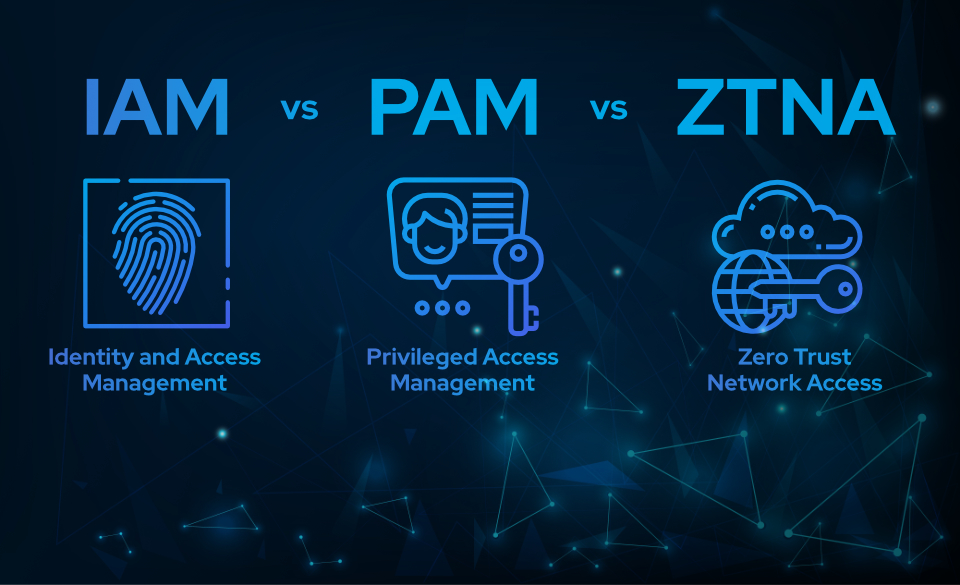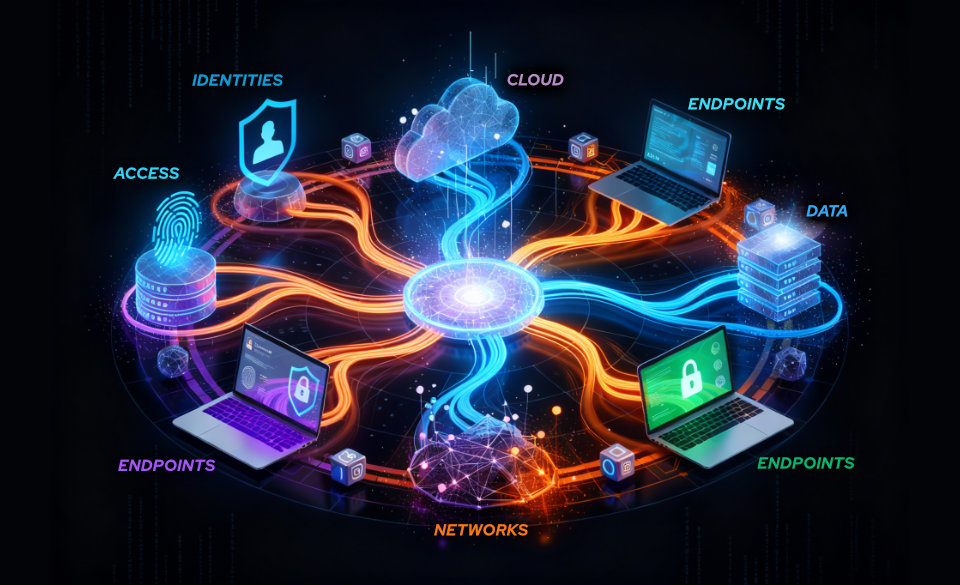
Zero Trust Network Access (ZTNA): Everything You Need to Know
10 de April de 2025
Network Segmentation: The Art of Dividing to Protect
24 de April de 2025In the world of cybersecurity, three essential technologies are used to protect access to company resources: IAM (Identity and Access Management), PAM (Privileged Access Management), and ZTNA (Zero Trust Network Access). Although all of these solutions are related to access, each has a specific focus and purpose, aimed at addressing different security needs.
In this article, we will delve into each one of these solutions, their features, differences, use cases, and which one is most suitable depending on your company’s context.
1. IAM (Identity and Access Management)
Definition: IAM is a cybersecurity technology designed to manage and control user access to a company’s systems and resources. Its purpose is to ensure that only authorized people can access the right resources under the appropriate conditions, managing both identities and access permissions.
Features:
- Identity Management: Provides a centralized system for creating, modifying, and deleting user accounts.
- User Authentication: Verifies user identity using passwords, multi-factor authentication (MFA), and other methods.
- Authorization and Access Control: Controls which users have access to which resources and under what conditions, using role-based access control (RBAC) policies.
- Compliance: Facilitates compliance with privacy and security regulations, such as GDPR or the Sarbanes-Oxley Act.
Use Cases:
- Large organizations with many users: Companies with a large number of users who need access to various applications and resources, for example, in sectors like education, healthcare, or public administration.
- SaaS applications: In environments where users need access to multiple cloud-based applications.
Advantages:
- Centralizes the management of access and credentials.
- Improves security by allowing tighter control over who can access what.
- Facilitates regulatory compliance.
Disadvantages:
- Not enough to protect privileged access to critical systems.
- Does not offer specific control over the activities of users with elevated permissions.
2. PAM (Privileged Access Management)
Definition: PAM is a security solution that focuses on protecting accounts with privileged access, such as system, database, or critical application administrators. Privileged accesses allow users to make significant changes to systems, so their protection is crucial to avoid severe security breaches.
Features:
- Privileged Access Management: Controls access to accounts with elevated privileges, ensuring only authorized users can temporarily access these accounts.
- Privilege Escalation: Allows users to temporarily escalate privileges only when necessary and under supervision, preventing users from maintaining elevated privileges continuously.
- Auditing and Monitoring: Tracks all activities performed by users with elevated privileges, enabling audits to detect potential abuses.
- Dynamic Passwords: In many cases, PAM uses dynamically generated passwords for privileged users, which are constantly renewed to avoid credential reuse.
Use Cases:
- High-risk environments: Companies managing critical infrastructure, such as telecommunications, energy providers, banks, or governments.
- Protection of sensitive systems: Organizations needing to control access to databases, servers, applications, or high-value networks.
Advantages:
- Protects the most critical accounts, reducing the risk of internal or compromised attacks.
- Allows continuous supervision and detailed logging of actions performed by privileged users.
- Enhances security with dynamic passwords and temporary access.
Disadvantages:
- Implementing it can be complex, especially in environments with multiple systems and platforms.
3. ZTNA (Zero Trust Network Access)
Definition: ZTNA is a security approach that assumes no person or device, inside or outside the network, is trusted by default. Instead of allowing free access within the corporate network, ZTNA requires continuous verification of the identity and context of each access before allowing any type of connection to company resources.
Features:
- Continuous Authentication: The identity and authorization of users are validated continuously, even after the initial authentication.
- Micro-Segmentation: Divides the network into smaller segments, limiting access only to specific applications and data necessary for the task at hand, reducing the attack surface.
- Granular Access: Provides detailed control over which applications, devices, or users can access specific resources, based on very specific policies.
- Visibility and Continuous Monitoring: Monitors all interactions and activities of users within the network, providing full visibility over access.
Use Cases:
- Distributed environments and remote work: Companies with employees accessing resources from multiple locations, such as in hybrid work models.
- Cloud environments: Companies operating with cloud infrastructure or using cloud-based applications, and needing robust security to protect their data.
Advantages:
- Zero Trust minimizes risk by not trusting anyone by default, ensuring only validated users can access the necessary resources.
- Ideal for cloud environments and remote work, where the traditional security perimeter has disappeared.
- Micro-segmentation and granular access control significantly reduce internal threats.
Disadvantages:
- Its implementation can be complex, especially in traditional environments with legacy infrastructures.
- It may incur high costs and require significant resources to integrate and maintain the solution effectively.
Comparison: IAM vs PAM vs ZTNA for your company
| Feature | IAM | PAM | ZTNA |
| Main Focus | General identity and access management | Privileged access management | Zero Trust-based access management |
| Access Protection | Protects general access to systems and applications | Protects access to privileged accounts | Protects access to the network and resources based on identity and context |
| Auditing and Monitoring | Basic, focused on user access | Advanced, especially for privileged access | Advanced, continuous monitoring of access and behavior |
| Use Cases | Companies with many users and access to applications | Companies with critical systems and sensitive data | Distributed environments, remote work, and cloud |
| Privilege Control | Limited to general access | Full control over privileged access | Granular control of access, no trust in perimeter |
| Complexity | Moderate, easy to integrate | High, especially in complex environments | High, especially in traditional environments |
What Solution Does Your Company Need?
The choice between IAM, PAM, and ZTNA depends on your company’s needs and characteristics. If you’re looking to manage identities and access centrally for all your users, IAM is the right solution. If your priority is to protect accounts with elevated privileges on critical systems, PAM is the most secure option. Finally, if your company operates in a distributed or remote environment and needs robust security for all access, ZTNA is the best choice.
In many cases, a combination of these solutions is the most recommended, providing comprehensive access protection for your company.
All-in-One with Endurance
Endurance is the ideal solution for a company seeking an integrated approach to cybersecurity, combining the most advanced features of PAM, IAM, and ZTNA into a single platform. Through this integration, organizations can centrally manage the identities and access of all users, ensuring that only authorized individuals access the right resources at the right time. This identity management (IAM) ensures efficient and secure credential administration, facilitating regulatory compliance and improving access visibility.
But Endurance goes further, also protecting privileged access with a robust PAM solution designed to control accounts with the highest permissions, which are the most vulnerable to attacks. Endurance not only protects these accounts but also allows continuous monitoring of their activities, helping to prevent and detect suspicious behavior before it can compromise security.
Finally, Endurance incorporates a ZTNA approach, meaning that each access is continuously validated, with no trust given to any device or user by default. This is especially useful in distributed environments or remote work models, as it ensures that only authenticated users with the appropriate context can access company resources, regardless of their location.
With Endurance, organizations get an all-in-one solution that not only simplifies access management but also enhances security, operational efficiency, and regulatory compliance. By integrating these three technologies into a single platform, complexity, costs related to multiple tools, and the risk of security breaches are reduced, providing complete and easy-to-manage protection.




